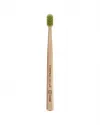

















 Swiss premium oral care
Swiss premium oral care
 United Arab Emirates
United Arab Emirates

Finally, the wooden toothbrush that truly cares for your teeth and gums – as well as the environment. An ultra soft brush head with 4,440 ultra fine Curen® filaments densely packed together... coupled with ultra hard, ultra durable, sustainably-sourced beech wood.
Try this toothbrush… love this toothbrush. Feel connected with nature every morning and every evening. With the beautiful, earthy warmth of the biodegradable, compostable handle and the joyful colour of the brush head filaments – this is a work of art you could lovingly gift to family and friends.
This is the same groundbreaking technology and design excellence used in all our iconic toothbrushes – recommended by dentists and loved by millions. Wooden no longer means less efficient. The Curaprox wood ultra soft is relentless on plaque… and relentlessly gentle on your teeth and gums. Brush for a smile that lasts a lifetime.
Swiss beech is known for its durability. And it’s the only wooden toothbrush with the Curacurve® bend – so you can easily get to all those hard-to-reach spots
Break off the brush head using pliers or similar. Throw the brush head away in your normal bin. Pop the 100% biodegradable wooden handle in your compost bin. We recommend replacing your wooden toothbrush every two months (to avoid bent filaments and the build-up of potentially harmful bacteria).
We passionately support the sustainable cultivation of beech wood… to maintain a healthy forest ecosystem in Switzerland for generation after generation.
We care about oral health. And we care about the planet. That’s why our founder, Ueli Breitschmid, launched the Ama Pianeta label – to respect nature, fauna and flora, our environment and our society.
Ama Pianeta stands for – among other things – the sustainable cultivation of food, the maintenance and promotion of natural processes… and the careful use of our resources.
 Swiss premium oral care
Swiss premium oral care

